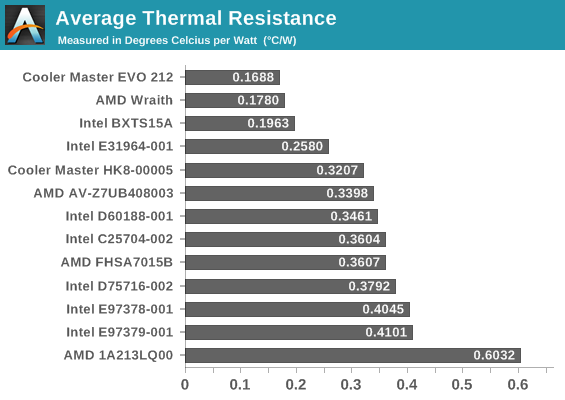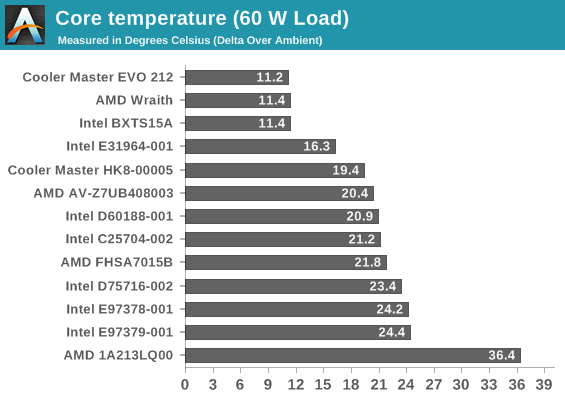Battle of The CPU Stock Coolers! 7x Intel vs 5x AMD, plus an EVO 212
by E. Fylladitakis on July 22, 2016 9:00 AM EST- Posted in
- Cases/Cooling/PSUs
- CPUs
- AMD
- Intel
- Cooler Master
- Cooler
Testing Results, Maximum Fan Speed (12 Volts)
Most of the stock coolers were tested with a maximum load of 150W, lest we start a fire. These products were not meant to handle thermal loads way higher than the stock specifications of the CPUs they were being shipped with.

Looking immediately at the average thermal resistance and we see three main coolers out in front, and it is no surprise that these three are the beefiest - the EVO 212, the Wraith and the BXTS15A. The small Kabini cooler is designed for very low power, and our small test here pushes it outside of its window.

| Core Temperature, Constant Thermal Load (Max Fan Speed) |
As we move up the thermal loads, from 60W all the way up, the coolers by and large stay in their positions, with small differences becoming more pronounced as the load increases.

The EVO's large 120mm fan keeps the RPM down here, and it is interesting to see the RPM and noise of the BXTS15-A go far and above the other coolers.

An interesting observation would be that Intel’s coolers meant for a specific socket have about the same absolute thermal resistance regardless of the core’s material. Taking socket 775 coolers as an example, the aluminum D75716-002 performs similarly with the copper C25704-002, most likely due to its solid core, and the tall copper D60188-001 also performs similarly due to the much slower (and quieter) fan. The same goes for the aluminum E97379-001 and the copper E97378-001 socket 1155 coolers, the former of which simply has a significantly more powerful fan attached. The E31964-001 performs significantly better but its high performance is not just due to its size and copper fins, as the fan is quite fast and loud as well.
In AMD’s camp, the simple and cheap FHSA7015B displays reasonable thermal performance at the expense of comfort, as the maximum speed of its fan is quite high. The more advanced AV-Z7UB408003 offers only slightly better thermal performance but noise levels were significantly lower. The Cooler Master HK8-00005 beats both of the aforementioned coolers in terms of thermal performance but its noise levels are rather high. This was to be expected, as it is based on the core design of the AV-Z7UB408003 but is significantly smaller, therefore a more powerful fan would have to make up for the loss of mass. Finally, the small 1A213LQ00 realistically has by far the worst overall performance of every cooler we tested here today, as the little cooler is designed with AMD’s power efficient AM1 CPUs in mind and cannot be directly compared to any of the other coolers in this review.
Both of AMD’s Wraith and Intel’s aftermarket BXTS15A stand out, pulling ahead in terms of performance the rest of the stock coolers. AMD’s Wraith is but a breath away from Cooler Master’s EVO 212 and the BXTS15A does not fall far behind. There is a catch though and that is the fans. Both the Wraith and the BXTS15A are making use of very strong fans, with a much higher top speed than that of the 120 mm fan that the EVO 212 is using. Strong fans are not just inherently louder themselves but the high air turbulence they create effectively multiplies the sound pressure level of the setup.










82 Comments
View All Comments
Cygni - Friday, July 22, 2016 - link
You thought that's what this comparison was about? Really? People swapping stock coolers? REALLY?SetiroN - Friday, July 22, 2016 - link
You don't get sarcasm even when explicitly pointed out? REALLY?ImSpartacus - Sunday, July 24, 2016 - link
I've got a 212 in my machine and I nearly went stock, so this is an absolutely fantastic comparison in my opinion.Very unique & helpful article, overall. It's amazing how such a simple topic can be so deceptively useful.
cknobman - Monday, July 25, 2016 - link
The point of the entire article was to provide information for someone that wanted to use the stock cooler.Heck I'm rocking a 212 myself because I cannot see spending more $$$.
Now if AMD would only bundle a processor worthy of the freaking cooler I might buy one!!!
blackmagnum - Friday, July 22, 2016 - link
Tip: Don't forget to clean the fans once in a while.fanofanand - Friday, July 22, 2016 - link
I think there is one tiny component here that was overlooked, and that is ease of installation. The stock coolers are FAR simpler to install, weigh significantly less, and therefore cause less stress on your motherboard. That isn't a big deal when you have a high-end ROG board or the like, but on cheaper, thinner motherboards not having 400+ grams hanging off the side is pretty nice.ZeDestructor - Friday, July 22, 2016 - link
Have you ever used push-pins? I personally abhor pushpin coolers - damn thing doesn't go into the board half the time and results in needing 4 tries (including cleaning and reapplying TIM) before the damn thing is in....Honestly, I'd pay the extra cost of a half-decent cooler like a Noctua NH-L9x65 or Cryorig M9i just so I can use a bunch of simple, solid screws instead.
PS: even OEMs agree - their coolers are just the reference intel coolers, but with screws and an as-cheap-as-possible backplate to screw into.
jabber - Friday, July 22, 2016 - link
I detest the push pins too. Just cant get on with them.Zap - Saturday, July 23, 2016 - link
Push pins are super simple to use once you figure them out. You can't just place the heatsink on top of the CPU and mash down the pins. That's the path to tears and frustration. I've installed hundreds of them, and can nail the install in one try. They are secure enough that you can pick up the motherboard using the heatsink and wave it around.What you do is to guide the pins until they go through the holes in the motherboard and the base (translucent white part) is sitting flush against the motherboard. THEN you press down on the black pins until they click. Go diagonally, as you would installing wheels on your car. For the first pin, you'll have to hold down the heatsink so it doesn't tilt.
ZeDestructor - Sunday, July 24, 2016 - link
It's a royal pain to line the cooler up when the board is installed in the case since you have no lateral or underside vision to see that the pins are lined up before you can push in, so you basically guesstimate where it is based on pin movement, find it feels like it's in the hole, press down on the pin... aaaaand crunch! Now, you swear some oaths about the bloody moron who designed the damn thing as you find that you've successfully crushed half of the pin out of the hole, making the bloody thing even more annoying to line up successfully blind.No, I'll stick to 4 zinc-plated steel screws tyvm.